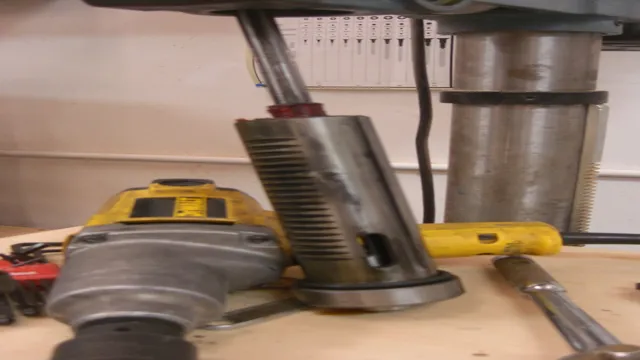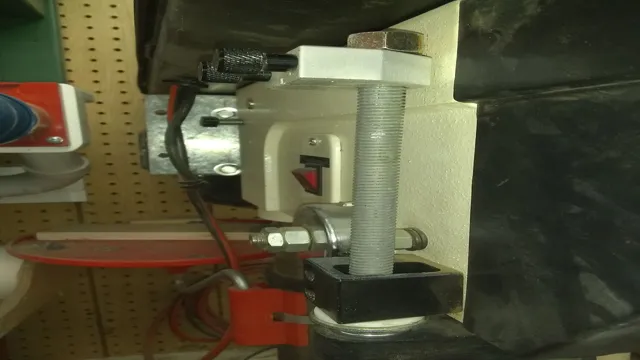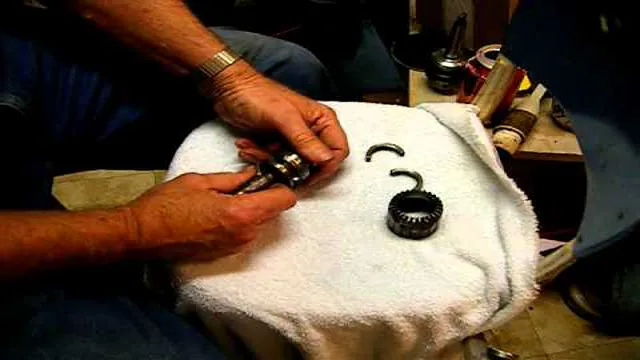
When it comes to drilling holes in wood, metal, and other materials, a drill press is a versatile tool that finds great use in both DIY and professional settings. The drill press’ quill is an integral part of this handheld equipment, and it’s essential to use it properly for effective drilling. With that said, have you ever wondered what the function of a drill press quill is? The answer to this question is crucial for anyone aiming to make the most out of their drill press.
In this blog post, we will dive deeper into the function of a drill press quill and how to use it effectively. So, sit tight and read on!
Understanding the Parts of a Drill Press Quill
If you’re new to using a drill press, you might be curious about how the drill press quill works. Essentially, the quill is the part of the machine that holds and moves the drill bit up and down. It’s a cylindrical piece that fits into the head of the drill press, and it’s controlled by a lever or handle that you can adjust to set the drilling depth.
Inside the quill, there’s a spring that helps to keep the drill bit stable while it’s drilling, and there are also bearings that help it to move smoothly. When you lower the quill, the drill bit also moves downward, and when you raise the quill, the bit moves back up. It’s a simple but important mechanism that makes the drill press a versatile and reliable tool for a wide range of applications.
The Quill Body
When it comes to drill press quills, one important component to understand is the quill body. This is the part of the quill that houses the drill bit and moves up and down during operation. The quill body typically consists of a hollow tube with a series of grooves or ridges that allow it to slide smoothly within the drill press column.
In addition, the quill body has a locking mechanism that holds the drill bit securely in place while drilling. The design and construction of the quill body can vary among different drill press models, but it is important to understand its role in achieving accurate and precise drilling results. By recognizing the key features of the quill body, you can make informed decisions when selecting and operating your drill press.

The Quill Feed Lever
If you’re new to using a drill press, you may wonder what the quill feed lever is and what purpose it serves. The quill feed lever is an essential part of a drill press’s quill assembly, which controls the spindle’s up-and-down movement. The lever is typically located on the right-hand side of the headstock and is used to adjust the spindle’s depth of cut.
By moving the lever, you can raise and lower the quill and, consequently, the drill bit. This is useful for achieving precise drilling depths and preventing the bit from going too deep or not deep enough. Getting the right drilling depth is critical when working with a drill press, and the quill feed lever is an essential tool to help you achieve it.
So if you’re looking to improve your drilling accuracy, mastering the quill feed lever is a must!
The Quill Stop
A drill press quill is an essential component that moves up and down to drill a hole in a workpiece. The quill stop is usually located at the top of the quill and helps to control its depth movement. This stop is adjustable, allowing you to set the depth according to the requirements of the job.
The quill stop also provides an added level of safety by preventing the quill from going too deep and damaging the workpiece or the drill bit. Understanding the parts of a drill press quill, including the quill stop, is crucial for any woodworking enthusiast or professional. By mastering these components, you gain better control over your drilling task, making your work more precise and efficient.
How It Works
If you are wondering how a drill press quill works, it’s actually quite simple. The quill is a component found in the drill press that holds the drill bit in place and allows it to move up and down. When you turn on the drill press, the motor rotates the spindle, which is connected to the quill.
As the spindle turns, it moves the quill up or down, depending on how you adjust the depth stop. This movement is what allows you to drill holes of different depths. Additionally, the quill has a spring that provides resistance against the drill bit, ensuring that it stays in place while you drill.
And that’s all there really is to it! The quill is an essential part of the drill press, and understanding how it works can help you use this tool more effectively.
The Role of the Spindle
When it comes to machine tools, the spindle plays a crucial role in their operation. It’s responsible for holding and rotating the cutting tool that performs the machining operation on the workpiece. The spindle is fixed on the tool head of the machine and is usually driven by a motor, which rotates it at high speeds.
This rotation creates the necessary force to cut into the workpiece and shape it to the desired specification. The spindle can also be adjusted for different cutting speeds and feeds, depending on the type of material being machined. This flexibility allows it to work with a variety of materials, from soft to hard metals.
Overall, the spindle is an essential component that enables machine tools to perform precise and accurate machining operations.
The Role of the Quill
The quill has long held a significant role in written communication, and while it may no longer be the primary tool used for writing, it still holds a lot of value. How it works is quite simple: the quill is dipped in ink before being used to write on paper. The ink is then absorbed by the paper, resulting in a permanent mark.
The quill’s design is what makes it so effective at writing, with its pointed tip allowing for precise and intricate strokes. The quill’s history dates back hundreds of years, and its effectiveness has made it a popular tool for artists and writers alike. While we may now have access to more advanced writing tools, the quill’s timeless charm and effectiveness make it a tool that will always have a place in written communication.
The Role of the Feed Mechanism
When it comes to the workings of a sewing machine, the feed mechanism plays a crucial role. This mechanism is responsible for moving the fabric forward as you sew, ensuring a consistent stitch length. The feed dogs are a set of metal teeth that grip the fabric and move it along as the machine needle passes through.
Different types of feed mechanisms can be found on different sewing machines, with some including bottom feed, differential feed, and drop feed mechanisms. The feed mechanism’s design can have a significant impact on the fabric’s movement, and therefore the quality of the stitch. Ensuring the correct feed mechanism is used for the task at hand can make all the difference in achieving professional-looking results.
So next time you fire up your sewing machine, take a moment to appreciate the humble feed mechanism’s importance.
Using a Drill Press Quill
How does a drill press quill work? A drill press quill, also known as a spindle, is the vertical component that houses the drill bit. The quill is attached to the drill press’s column and is responsible for the up and down movement of the drill bit. A spindle return spring helps with this movement.
The quill also has an internal taper that fits into the machine’s motor-driven spindle, allowing it to rotate. The drill bit is placed into the quill’s chuck, which clamps the bit in place. As the drill press is turned on, the spindle will lower, making contact with the workpiece.
The operator can then apply downward pressure, and the drill bit will create a hole. The quill’s depth stop allows for consistent hole depths, which is useful when working on multiple pieces. Thanks to the drill press quill, drilling holes in materials becomes fast and easy.
Adjusting the Quill Depth
If you’re looking to adjust the depth of your drill, look no further than a drill press quill. Using a drill press quill can make the adjustment process quick and easy, saving you valuable time and effort. Simply attach the quill to the drill press and adjust the depth to your desired setting.
The quill allows for precise adjustments, ensuring that your drill goes exactly where you want it to. With a drill press quill, you can easily create consistent and accurate holes every time. So why struggle with manual adjustments when a drill press quill can make the process so much simpler? Give it a try and see the difference for yourself.
Changing the Drill Bit
Changing the drill bit on a drill press can be a simple process if you follow the right steps. Using a drill press quill can help you to change the bit quickly and easily. First, set the machine to the correct speed and make sure it’s turned off.
Then, insert the quill into the chuck of the drill press and loosen the chuck by turning it counterclockwise. Remove the old bit and insert the new one, making sure it’s secure by tightening the chuck back up. Finally, check the bit to make sure it’s straight and properly aligned.
With the help of a drill press quill, you can easily change your drill bits to suit any job at hand.
Conclusion
To put it simply, a drill press quill is like the magic wand of the tool world. It moves up and down, allowing you to drill precise holes in your workpiece with ease. But don’t be fooled by its seemingly simple design – the quill is a truly genius invention.
It uses a combination of gears and pulleys to efficiently transmit the power from the motor to the drill bit, while also providing a smooth and stable drilling experience. So there you have it – the drill press quill is a true standout in the world of power tools, making drilling a whole lot easier and a whole lot more fun!”
FAQs
What is a drill press quill?
A drill press quill is the part of the press that connects the spindle to the feed mechanism.
How does a drill press quill work?
The quill moves up and down, thanks to a feed mechanism, which allows the drill bit to drill down into the material.
What is the function of a drill press quill lock?
A drill press quill lock holds the quill in place, so the operator can make precise adjustments to the depth of the hole without losing their place.
How do you adjust the depth of a hole on a drill press with a quill?
By raising or lowering the quill, the operator can adjust the depth of the hole.
How do you properly maintain a drill press quill?
Regular cleaning and lubrication will help to keep the quill in good working condition for longer.
How do you know when a drill press quill is not working correctly?
If the quill is loose or wobbly, or if it is not moving smoothly up and down, this may indicate a problem.
Can a drill press quill be replaced?
Yes, a faulty quill can be replaced by a professional repair person. However, this can be costly and time-consuming, so regular maintenance is recommended to avoid this.








